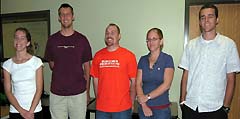
Five students from the Redeemer University College Sciences Division enjoyed an opportunity to pursue a research project in more depth this summer by joining with a professor. The students were all supported by NSERC (Natural Sciences and Engineering Research Council of Canada) and two of the students were also supported by HRSDC (Human Resources Skills and Development Canada Summer Career Placement Program).
Four of the students received Undergraduate Student Research Awards (USRAs) worth $4500 each, plus additional salary for the summer term. Every year since 1999, Redeemer professors have hired students to join them in summer research under the USRA program of NSERC.
Quite regularly, summer student research has resulted in coauthored publications with Redeemer professors in high quality refereed journals. We expect to see further articles forthcoming based on the success of the research this past summer as well.
Eric Windhorst worked with Dr. Edward Berkelaar to study selenium accumulation by wheat seedlings. Eric grew plants hydroponically, and exposed them to precise amounts of selenium. He then harvested plants and exposure solutions, prepared them for analysis, and analysed them for selenium by graphite furnace atomic absorption spectroscopy.
Art Smit worked with Dr. Derek Schuurman, assisting with research into a robust approach to robot and computer vision for position measurement in the presence of occlusions.
Marieke Van Walderveen worked for Dr. Gary Chiang. She isolated Malpighian tubules (a.k.a., insect kidneys) from different species of insect and measured how much of the organic anion, salicylate, they secreted. This work was done in Dr. Mike O’Donnell’s laboratory at McMaster University.
Loretta VanderSpek also worked at McMaster under the supervision of Dr. Wytse van Dijk and McMaster’s Dr. D.W.L. Sprung. Her project involved a theoretical study of electron transport through layered semiconductors. She looked at such transport when the device or junction was biased by a voltage. Her work included mathematical analysis, computer algebra and programming, and graphical displayof the results.
Matthew West did mathematical research with Dr. Vander Meulen, exploring a relatively new branch of mathematics called qualitative matrix theory. In brief, Matthew explored properties of matrices which are determined by the pattern of nonzero entries in a matrix. His work with Dr. Vander Meulen will be presented at a workshop at the American Institute of Mathematics this month.
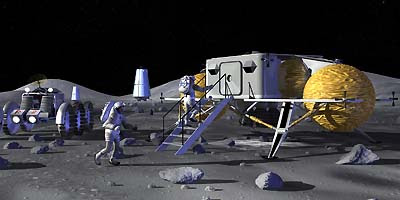 Earlier this month NASA announced plans to construct a base at one of the moon's poles. The poles are in near constant sunlight, which will allow for solar power generation at the base.
Earlier this month NASA announced plans to construct a base at one of the moon's poles. The poles are in near constant sunlight, which will allow for solar power generation at the base.
 Last May, papers on Rhodnius Prolixus by Dr Gary Chiang,
Last May, papers on Rhodnius Prolixus by Dr Gary Chiang, 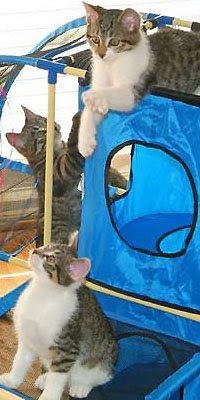 Copy Cat, the world's first cloned cat, has had a litter of three kittens. The kittens were born in September and appear healthy. However, Copy Cat is not the first cloned cat to give birth. In New Orleans, two cloned wild African cats successfully mated to produce kittens.
Copy Cat, the world's first cloned cat, has had a litter of three kittens. The kittens were born in September and appear healthy. However, Copy Cat is not the first cloned cat to give birth. In New Orleans, two cloned wild African cats successfully mated to produce kittens. A report in today's Science magazine extrapolates that the Ebola virus has killed more than 5000 gorillas in West Africa. Ebola could be a more important factor in the decline of great apes (by almost 50%) across central Africa in the last two decades than the bushmeat trade or deforestation. The basis of the report was a study of a group of western gorillas in the Lossi Sanctuary in northwest Republic of Congo.
A report in today's Science magazine extrapolates that the Ebola virus has killed more than 5000 gorillas in West Africa. Ebola could be a more important factor in the decline of great apes (by almost 50%) across central Africa in the last two decades than the bushmeat trade or deforestation. The basis of the report was a study of a group of western gorillas in the Lossi Sanctuary in northwest Republic of Congo. The
The  A
A  A
A  The inaugural edition of the Newsletter from the Sciences Division at Redeemer University College is available for downloading from
The inaugural edition of the Newsletter from the Sciences Division at Redeemer University College is available for downloading from  Five students from the Redeemer University College Sciences Division enjoyed an opportunity to pursue a research project in more depth this summer by joining with a professor. The students were all supported by NSERC (Natural Sciences and Engineering Research Council of Canada) and two of the students were also supported by HRSDC (Human Resources Skills and Development Canada Summer Career Placement Program).
Five students from the Redeemer University College Sciences Division enjoyed an opportunity to pursue a research project in more depth this summer by joining with a professor. The students were all supported by NSERC (Natural Sciences and Engineering Research Council of Canada) and two of the students were also supported by HRSDC (Human Resources Skills and Development Canada Summer Career Placement Program).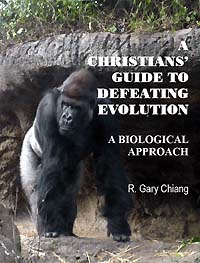 Dr. Gary Chiang has published his second book on evolution. With chapter aims and questions, this workbook is designed to facilitate group study of what the science of biology can tell us about evolution. Gary took the gorilla picture this summer while vacationing in Australia with Jennifer.
Dr. Gary Chiang has published his second book on evolution. With chapter aims and questions, this workbook is designed to facilitate group study of what the science of biology can tell us about evolution. Gary took the gorilla picture this summer while vacationing in Australia with Jennifer. 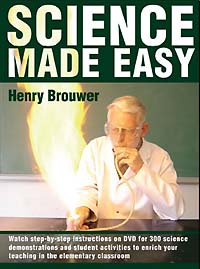 Dr. Henry Brouwer has completed Science Made Easy, a set of 4 DVD's of 300 science demonstrations to assist elementary teachers with doing science activities. The DVD's can be bought through the Redeemer University College Bookstore.
Dr. Henry Brouwer has completed Science Made Easy, a set of 4 DVD's of 300 science demonstrations to assist elementary teachers with doing science activities. The DVD's can be bought through the Redeemer University College Bookstore.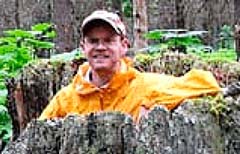 B.Sc., Honours Biology, RUC, 1996
B.Sc., Honours Biology, RUC, 1996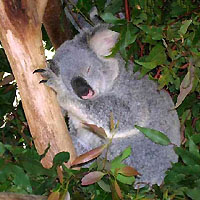 Koalas depend on eucalyptus trees for shelter and food. They sleep about 20 hours a day and sit and munch food for 1 to 3 hours a day.
Koalas depend on eucalyptus trees for shelter and food. They sleep about 20 hours a day and sit and munch food for 1 to 3 hours a day. 
 Tasmanian Devil is a carnivorous and scavenging marsupial now restricted to Tasmania. Its the size of a small dog with large males weighing up to 12 kg, and standing about 30 cm high at the shoulder. Devils have been extinct on mainland Australia for some 600 years, before European settlement, ousted by the dingo brought into Australia by Aboriginal people.
Tasmanian Devil is a carnivorous and scavenging marsupial now restricted to Tasmania. Its the size of a small dog with large males weighing up to 12 kg, and standing about 30 cm high at the shoulder. Devils have been extinct on mainland Australia for some 600 years, before European settlement, ousted by the dingo brought into Australia by Aboriginal people. 